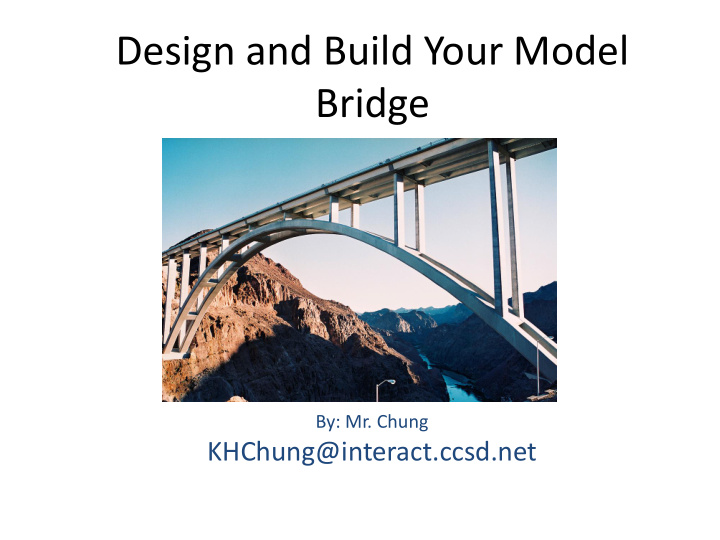



Design and Build Your Model Bridge By: Mr. Chung KHChung@interact.ccsd.net
Main Materials: • Grid paper (12”x18”) • T-pin • Pencil (# 2, or 2-H) • Wax paper • Ruler (metric) • Sand paper • Cutting tools • Bull nose clamp • Glues (Elmer’s or • ¾ binder clamp wood) • Cutting mat • Ceiling tile • 3/32 basswood (density about .07 gram per 1 inch)
Optional Tools • Triple beam • Torpedo level balance • Dremel tool • Needle file • Blue tape • T-Square • Drafting triangle • Safety goggles • Tweezers • Compass
Know the Rules a. Be able to define in your own words what the bridge must accomplish b.Limit the bridge weight c. Keep it simple d.Do not get disqualified!!!!
Start with grid paper Use ruler to establish the center of the bridge
Draw the loading area.
Design the Bridge a. Design the bridge around the loading points – Plan for extra bracing around load areas b. Choose a truss to use – Warren – Pratt – Howe – K truss c. Draw the bridge to scale – Use graph paper – Draw forces – Label everything
Truss Design • Warren • Pratt • Howe • K-Truss
Draw the top and bottom of your bridge Locate the point where you can use to build the internal members
Draw the internal members
Draw the two side members to connect the top and bottom of the bridge.
Make the top chord of the bridge thicker by drawing the a second and third lines to product the shape of 1-3 sticks.
Possible top design
Design the top of your bridge. Please note that the sides of the bridge will be longer because of the slope.
Cut and glue the outer members of your bridge Make sure to put wax paper down first!
Glue the vertical members
Glue the diagonal members
Make another truss the same as the first
Here are the trusses ready to build your bridge
Use the T-pins to set up the two trusses
Make sure the two trusses are at 90 degree s with the base.
Look down the two ends to make sure they are 90 degree s with the base
Connect the trusses with cross members
Look down the two ends to make sure the bridge is still at 90 degree s with the base
Add the diagonal members
Check to make sure the bridge still look s good from the two ends
At the bottom cross members
Sand any extra unwanted wood to reduce the mass of the bridge and you are done.
Good Tips • Try not to use too � � � � � glue • Practice good craftsmanship • Sand extra weight off • Be creative • Make and test as many bridges as possible • Try out different truss design • Look around your environment for idea • Use Elmer's or wood glue (CA glue dr � � � too fast)
Good Resources • http://www.garrettsbridges.com/design/truss design • http://www.jhu.edu/virtlab/bridge/bridge.ht m • http://pghbridges.com/basics.htm • http://www.knexusergroup.org.uk/acatalog/K 96168X.pdf
Please give warm thanks to the following people : Paul, Walt, Casey, Tanner, Charles, Steven, Janet, and Richard, and many others for making this event very successful every year. Thanks You For Coming See you on March 2, 2013
Recommend
More recommend